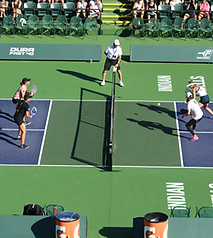Instructional articles

Curtis Smith’s introduction to pickleball was a reluctant one. An advertising and marketing executive who worked for a large department store, he’d never played the game that his brother, Cody, was so passionate about. But, like many family business stories, when one family member has an overwhelming drive, the others tend to follow.
“Cody kept asking me to work with him, and I said no because I had no idea what pickleball was, and it wasn’t my primary business,” Curtis said. “Then, Cody needed help making 60 paddles for a coffee demo event, and he couldn’t go because of his day job, so I helped him out. I thought maybe 30 people would show up. Curtis never made it to his vendor’s table that day. “There were more than 200 people at the event. I was swarmed with people pulling paddles out of the boxes for two hours,” he said. “I went home and told Cody that if he gave me half the company, I’d run it.”
Paddletek’s polymer paddle was revolutionary at the time. Now used by 80 percent of the market, polymer designs were the solution to a problem pickleball players had been facing for years—finding a durable paddle that responded to the needs of the player. “It changed the sport. Old Nomex paddles wore out and aluminum paddles dented over time,” Curtis said. “Polymer paddles were intuitive. They change in response to the situation. They were meant for pickleball.”
Since those early days, Paddletek has remained committed to its designs. Where some companies focus on trends and “latest and greatest,” Paddletek is focused on durability and the needs of the player. “Rather than us change our recipe, we want to simplify the message for consumers,” Curtis said. “We could make a paddle an ounce lighter, but when you change the weight by more than half an ounce, you dramatically change the way it plays. We’d rather say, ‘This is the shape and material; you choose your weight,’ and then explain to players how that will perform. Our Bantam EX-L, for example, is popular with tennis players because of its weighted balance and response, whereas our Bantam TS-5 is really light.”
Always thinking about the players, Paddletek’s also looking at increasing durability in pickleball paddles, creating legacy pieces that can be handed down to the next generation. “Right now, we’re looking at everything as if we had to start from scratch and saying, ‘How do we make this longer lasting?’ How do you make a five- or 10-year paddle,” Curtis said. “When you buy a good tennis racquet, you can just get it restrung. What plays as well as polymer but will still be good eight years from now? We put more energy into that than changing the spec a bit and claiming innovation. If I’m spending $150 on a new paddle, I want to be able to give it to my grandkids.”
That drive to solve problems for the players and not just feed the bottom line has been the key to Paddletek’s success since the beginning. And while the company’s grown and changed since its reluctant start, so has Curtis, who is now a pickleball player who plays mostly with his family and coaches his son. He’s even played in his local, regional tournament, where he won silver—an accomplishment he likes to joke about. “There were only two of us in the match,” he said. “So I came in second, but I also came in last.”
For more information on Paddletek, visit paddletek.com.
Dinking 101: 5 Steps to a Winning Dink
Here at Pickleball Channel we talk a lot about dinking, or the soft game, but what exactly is a dink, and how can it improve your game? Today we're going to go back to the basics and hear from pickleball ambassador, Tom Earley, in one of our most popular shows, “Pickleball 411”.

READ MORE
The Offensive LOB for Beginners
To be a successful lobber from the kitchen line, one of the most important aspects to focus on is your ability to disguise the shot. You need to dink the ball and lob the ball with the exact same smooth pendulum motion.








